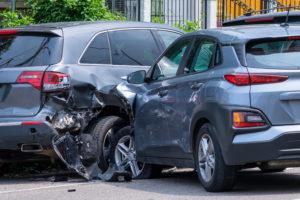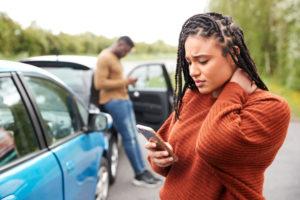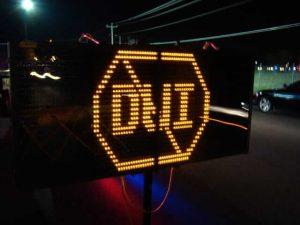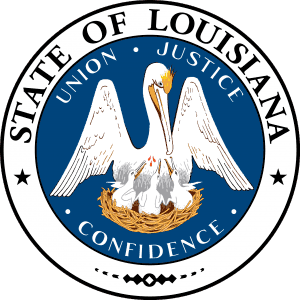
Car accident injuries can happen to anyone at any time. There are many crashes—from minor fender benders to fatal accidents — in Birmingham, Alabama every day. Knowing the top causes of car accidents in Birmingham, AL and nearby areas can help you understand who may be at fault, your rights as a victim, and what to do next.
Keep reading to learn how crashes happen and your options for pursuing justice and compensation from our personal injury law firm serving Birmingham, greater Jefferson County, and all areas of Alabama, Mississippi, Louisiana, and Arkansas. We may be able to help you get a fair insurance settlement or another payout if you were hurt in a Birmingham traffic accident.
What Are the Most Common Causes of Collisions in Alabama?
While there are no statistics available specific to the city of Birmingham, taking a look at the state as a whole and Jefferson County specifically (Birmingham is the County Seat) can give us a good idea of some common reasons why vehicles collide in Birmingham.
According to the Alabama Department of Transportation (DOT), in 2019, Jefferson County had:
- 34,732 car accidents
- 7,592 car accident injuries
- 85 car accident fatalities
Inside the city limits of Birmingham, law enforcement reported:
- 19,210 car accidents
- 4,289 car accident injuries
- 38 car accident deaths
The Alabama DOT also reported the top causes of traffic accidents in Alabama in 2019, including:
Speeding
Speeding is a very common contributor to crashes in Alabama and nationwide. According to the National Highway Traffic Safety Administration (NHTSA), for more than 20 years, speeding has been involved in about one out of every three crashes in the United States. In 2019, it was reported as a contributing factor in 26 percent of fatal car accidents.
Speeding—whether exceeding posted speed limits or driving too fast for conditions—is a problem for several reasons. First, it gives drivers less time to make decisions and react to hazards. Second, it can cause them to lose control of the vehicle. It will be more difficult to hold in their lane, navigate curves, and stop quickly.
Lastly, when there is an accident, the forces are greater when one or both vehicles are speeding. It amplifies the forces in the crash, leading to more serious injuries and a higher likelihood of fatalities.
Intersection Accidents
The Alabama DOT reported 93,826 total intersection-related crashes in Alabama in 2019, including 22,130 in Jefferson County alone. This is about 64 percent of all the collisions law enforcement recorded during the year in Jefferson County. While many of these are rear-end crashes, others occur because a driver:
- Failed to yield the right of way
- Failed to heed a stop sign
- Failed to obey a traffic signal
- Failed to stop before turning right on red or left on green
These crashes can be particularly dangerous because of the chances of a T-bone collision, where one vehicle collides with the side of another. On the side of a car, there is less metal, foam, and other materials to dissipate the force of the crash.
So when a driver sails through an intersection and crashes into the driver or passenger’s door of another car, the occupants in the car can suffer significant injuries. Entrapment is common, too.
Driving Under the Influence of Drugs or Alcohol
Drunk or drugged driving is a significant contributing factor to many car accidents in Birmingham and beyond. Alcohol and drug use can alter someone’s ability to make good decisions behind the wheel, focus on driving, react quickly, and even see the road ahead clearly.
Unfortunately, drunk driving collisions are also more likely to be fatal than other accidents. The Alabama DOT reports that 3.3 percent of accidents involving an impaired driver in 2019 included at least one fatality. Only 0.4 percent of other accidents were deadly. This means that alcohol-involved crashes were 7.62 times more likely to cause fatal injuries than other accidents.
Across Alabama, there were 930 total traffic fatalities in Alabama in 2019, and 210 of those involved alcohol or drug use. In Jefferson County, ten out of 85 fatality accidents involved impairment.
Issues With Lane Changes, Lane Use, or Merging
Improper lane changes are common on interstates, highways, and other areas where multiple lanes are moving in the same direction or merging might be necessary.
Drivers should take several steps before changing lanes, merging, or otherwise moving outside their lane. These include:
- Ensuring the other lane is clear
- Using their turn signal to indicate their intentions
- Moving into the adjacent lane slowly and with control
Following these rules should theoretically eliminate lane-change-related accidents related to blind spots, merging, lane changes, weaving, and other similar issues. Of course, drivers still act negligently at times and fail to uphold their driving responsibilities, causing crashes.
Because of their large blind spots and frequent travel on interstates, tractor-trailer trucks are often involved in this type of collision. While they should still ensure the adjacent lane is clear before moving over, it is good to be aware of a truck’s blind spots when driving near them.
Problems With Maintaining a Lane
While changing lanes is a common action that leads to crashes, so is failing to maintain a lane. This could occur for many reasons, from road hazards to distractions to alcohol or drug use. Examples of actions that could cause a crash include:
- Veering into an adjacent lane
- Crossing the centerline
- Running off the road
- Swerving to avoid another driver or hazard
- Driving on the wrong side of the road
Safe driving relies on each vehicle remaining in its own lane and only moving into another lane when allowed under specific circumstances, such as passing, merging, entering, or exiting. When a driver allows their vehicle to drift or veer or when they intentionally maneuver without ensuring it is safe, collisions are possible and maybe even likely.
Drowsy Driving
When you are drowsy, you not only risk falling asleep at the wheel, but you also have impaired cognition and performance. You cannot make decisions as readily, act as quickly, or generally perform as well. If this sounds like the effects of drunk driving to you, you are correct. In fact, some experts have compared the two, saying drowsy driving is as dangerous as impaired driving.
According to the NHTSA, drowsy driving crashes most commonly involve:
- Individuals in the vehicle alone
- Single-car accidents
- On rural roads or highways
- Drivers on the road between midnight and 6 a.m. or in the late afternoon
- A car that runs off the road with no sign of braking
While law enforcement attributes many crashes to falling asleep at the wheel or fatigued drivers, many more likely occur. It can be very difficult to determine when drowsy or fatigued drivers cause a collision because there are no obvious signs when the police arrive on the scene.
Rear-End Accidents
Rear-end crashes are among the most common types of accidents. They often occur at intersections or in traffic, when other vehicles stop but a driver further back fails to do so. This generally occurs for one of four reasons:
- The rear vehicle was following too closely, often called tailgating
- Misjudging stopping distance, commonly in wet conditions
- Speeding or traveling too fast for conditions
- Distractions preventing the driver from seeing the stopped traffic
Many people think of rear-end accidents as low-speed collisions that do not lead to serious injuries. However, any crash can cause significant harm and even lasting impairments or fatalities. For example, whiplash is a common injury in rear-end crashes. Whiplash can cause acute pain and limited motion, but some people also develop chronic pain and related symptoms.
Rear-end accidents, especially at higher speeds, can be serious. If you are involved in a Birmingham rear-end collision, you should treat it as you would any other accident and ensure you have any pain or other symptoms evaluated by a doctor as soon as possible.
For a free legal consultation, call 800-537-8185
A Special Note About Distracted Driving
You may be surprised that distracted driving or texting and driving does not appear on this list. The truth is it is a major cause of many of these accidents. It leads to the abovementioned incidents and can contribute as a causative factor in almost any of them.
However, it is not easy to prove, and it is generally unnecessary to prove it when you can show another of these top causes mentioned here occurred. For example, it is much easier to document that a driver ran a red light than it might be to show they were changing the radio station, looking at their GPS, or sending a text message.
In some cases, it may be fairly easy to prove distracted driving because of an admission, witness testimony, or video. Still, though, victims must show how the other party’s distraction caused them to violate another traffic law that directly caused the collision.
What Should I Do If I Am in a Birmingham Car Accident?
While we’ve discussed the top causes of car accidents in Birmingham, AL, do you know what to do if you are hurt in one of them? Taking the right actions after a crash can help your recovery—both physically and financially.
First, there are two things you should do at the crash scene:
- Report the accident to the police and have them file a report
- Seek medical care as soon as possible
Both of these steps are essential to your insurance claim or your case going forward. Of course, getting medical care is also vital for your health and should be your top priority if you are in pain, have any sign of injury, or are experiencing other symptoms. When you call 911, they will dispatch police and an ambulance to the scene.
The paramedics will evaluate you and recommend if you need to go to the nearest emergency department with them or if you can go on your own. If you prefer, you can have a friend or loved one take you, or you can see your family doctor or an urgent care physician for minor injuries.
Not only is calling 911 important for getting a medical assessment, but the responding officers will also document the scene, talk to witnesses, gather information, and file a report that includes their opinion about the cause of the crash. This may become key evidence in your case later.
Role of an Attorney in Your Case
As soon as your injuries are stable and you have a treatment plan in place, reach out to a local car accident attorney to discuss your options. Victims can seek compensation for their accident-related damages, including medical care, future expenses, lost wages, pain and suffering, and car repairs.
Your attorney can investigate what happened, gather evidence, develop a case, and pursue the compensation you deserve based on the facts of the case and the value of your losses.
Your Options Following a Birmingham Crash
Alabama’s tort laws allow accident victims to recover compensation from the at-fault driver. This usually happens out of court. Your attorney may file an insurance claim based on the at-fault driver’s liability policy. This is how most victims recover compensation.
However, if they cannot negotiate a fair settlement or there are other reasons to do so, your attorney may recommend suing the at-fault driver. You generally have up to two years to do this in Birmingham under Ala. Code § 6-2-38, but some exceptions may make the deadline in your case even shorter.
Click to contact our personal injury lawyers today
Talk to an Attorney From Morris Bart & Associates, LLC About Your Case for Free
You can speak to an attorney from the Morris Bart law firm today for free. Our team provides free consultations for victims of traffic accidents in Birmingham and elsewhere in Alabama. We can assess your rights and options, explain how we can help, and discuss the details of your case with you. We have offices in Birmingham, Huntsville, Mobile, and Montgomery and can meet you in other areas of the state, as well.
We are a contingency fee personal injury firm. We do not charge our clients anything upfront and only recover attorney’s fees if we secure compensation for the client. Contact us today to speak with a Birmingham car accident lawyer. You have nothing to lose.
Questions?Call 800-537-8185
to find a Morris Bart office near you.





